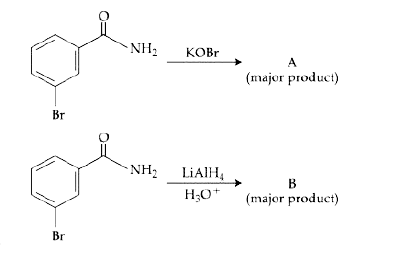A+B→ products is an elementary reaction. When excess of A is taken in this reaction,then the molecularity and order are respectively
2 and 2
2 and 1
1 and 2
1 and 1
The correct Answer is:B
To solve the question regarding the molecularity and order of the reaction A+B→products when excess of A is taken, we can follow these steps:
1. Identify the Reaction Type:
- The reaction A+B→products is stated to be an elementary reaction. This means it occurs in a single step and the stoichiometry directly reflects the molecularity.
2. Determine Molecularity:
- Molecularity is defined as the number of reactant molecules involved in an elementary reaction. In this case, we have one molecule of A and one molecule of B reacting together.
- Therefore, the molecularity of the reaction is 1+1=2.
3. Write the Rate Law Expression:
- The rate law for an elementary reaction can be written as:
Rate=k(A)1(B)1
- When A is in excess, the concentration of A does not change significantly during the reaction, and thus we can consider it constant.
4. Adjust the Rate Law for Excess A:
- When A is in excess, we can express the rate law as:
Rate=k′(B)1
- Here, k′=k(A) (where (A) is treated as a constant).
5. Determine the Order of the Reaction:
- The order of a reaction is defined as the sum of the powers of the concentration terms in the rate law expression. In this case, since we have only B in the rate law after considering A in excess, the order is:
Order=1
6. Final Answer:
- Thus, the molecularity of the reaction is 2 and the order of the reaction is 1.
Summary:
- Molecularity: 2
- Order: 1
- The reaction A+B→products is stated to be an elementary reaction. This means it occurs in a single step and the stoichiometry directly reflects the molecularity.
- Molecularity is defined as the number of reactant molecules involved in an elementary reaction. In this case, we have one molecule of A and one molecule of B reacting together.
- Therefore, the molecularity of the reaction is 1+1=2.
- The rate law for an elementary reaction can be written as:
Rate=k(A)1(B)1
- When A is in excess, the concentration of A does not change significantly during the reaction, and thus we can consider it constant.
- When A is in excess, we can express the rate law as:
Rate=k′(B)1
- Here, k′=k(A) (where (A) is treated as a constant).
- The order of a reaction is defined as the sum of the powers of the concentration terms in the rate law expression. In this case, since we have only B in the rate law after considering A in excess, the order is:
Order=1
- Thus, the molecularity of the reaction is 2 and the order of the reaction is 1.
- Molecularity: 2
- Order: 1
Topper's Solved these Questions
- CHEMICAL KINETICS BOOK - NARAYNACHAPTER - CHEMICAL KINETICS EXERCISE - EXERCISE -1 (H.W) HALF LIFE
6 Videos
- CHEMICAL KINETICS BOOK - NARAYNACHAPTER - CHEMICAL KINETICS EXERCISE - EXERCISE -1 (H.W) COLLISION THEORY
4 Videos
- CHEMICAL KINETICS BOOK - NARAYNACHAPTER - CHEMICAL KINETICS EXERCISE - EXERCISE -1 (H.W) ORDER OF REACTION
11 Videos
- CARBOXYLIC ACIDBOOK - NARAYNACHAPTER - CARBOXYLIC ACIDEXERCISE - All Questions
288 Videos
- CHEMISTRY IN EVERYDAY LIFEBOOK - NARAYNACHAPTER - CHEMISTRY IN EVERYDAY LIFEEXERCISE - ASSERTION & REASON TYPE QUESTIONS
10 Videos
Similar Questions
Knowledge Check
Molecularity of an elementary reaction
Amay be zeroBis always integralCmay be semi - integralDmay be integral fractional or zeroMolecularity of an elementary reaction
Amay be zeroBis always integralCmay be semi-integralDmay be integral, fractional or zeroConsider the following statements:
I) The value of rate constant is never negative
II) A zero order reaction is an elementary reaction
III). For elementary reactions, molecularity and order are equal
IV). Average and instantaneous rate of reaction are defined for micro and macroscopic time interval respectively The correct statement(s) is/areAI, II, IllBOnly IIICI, IIIDI, II, IV
Distinguish between order and molecularity of a reaction.
View SolutionFor which of the following reactions the molecularity and order of the reaction are respectively two and two
View SolutionMolecularity of an elementary reaction can be ______.
View SolutionIn an elementary reaction A+2B→products, the molecularity of the reaction is:
View SolutionFor an elementary reaction, 2A+B→C+D the molecularity is
View Solution

